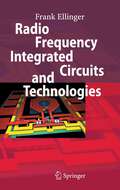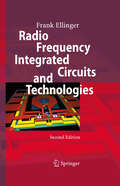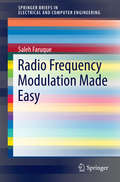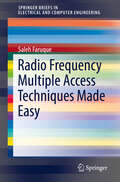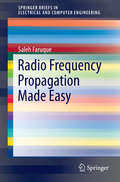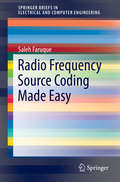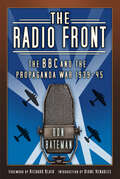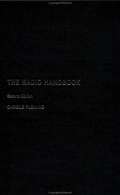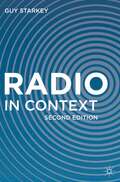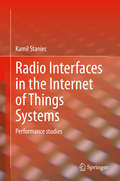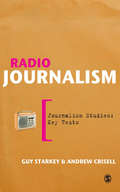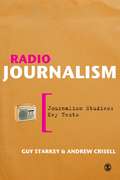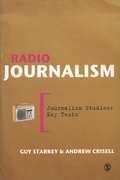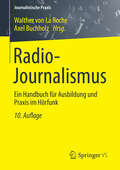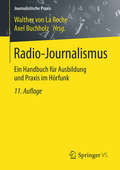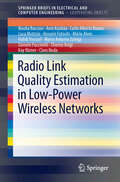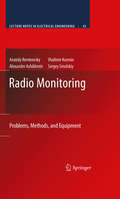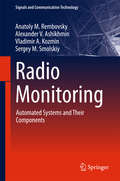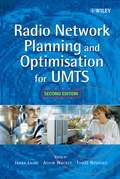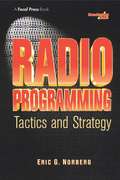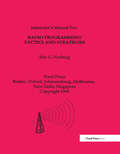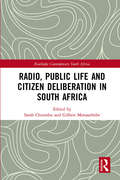- Table View
- List View
Radio Frequency Integrated Circuits and Technologies
by Frank EllingerThe striking feature of this book is its coverage of the upper GHz domain. However, the latest technologies, applications and broad range of circuits are discussed. Design examples are provided including cookbook-like optimization strategies. This state-of-the-art book is valuable for researchers as well as for engineers in industry. Furthermore, the book serves as fruitful basis for lectures in the area of IC design.
Radio Frequency Integrated Circuits and Technologies
by Frank EllingerThe striking feature of this book is its coverage of the upper GHz domain. However, the latest technologies, applications and broad range of circuits are discussed. Design examples are provided including cookbook-like optimization strategies. This state-of-the-art book is valuable for researchers as well as for engineers in industry. Furthermore, the book serves as fruitful basis for lectures in the area of IC design.
Radio Frequency Modulation Made Easy (SpringerBriefs in Electrical and Computer Engineering)
by Saleh FaruqueThis book introduces Radio Frequency Modulation to a broad audience. The author blends theory and practice to bring readers up-to-date in key concepts, underlying principles and practical applications of wireless communications. The presentation is designed to be easily accessible, minimizing mathematics and maximizing visuals.
Radio Frequency Multiple Access Techniques Made Easy (SpringerBriefs in Electrical and Computer Engineering)
by Saleh FaruqueThis book provides a comprehensive overview of multiple access techniques used in the cellular industry. The usage of multiple access techniques in telecommunications enables many users to share the same spectrum in the frequency domain, time domain, code domain or phase domain. Licenses are given, by the FCC, to operate wireless communication systems over given bands of frequencies, with the smaller bands, (channels), reused to provide services to other users. Thus, bandwidth efficiency is vital, as the speed and size of digital data networks continue to expand. This brief also uses numerous illustrations to bring students up-to-date in the practical applications of multiple access techniques, which can then be put to work in the industry. Primarily, electrical engineering students who study telecommunications, as well as engineers and designers working in wireless communications, would find this book useful.
Radio Frequency Propagation Made Easy (SpringerBriefs in Electrical and Computer Engineering)
by Saleh FaruqueThis book introduces Radio Frequency Propagation to a broad audience. The author blends theory and practice to bring readers up-to-date in key concepts, underlying principles and practical applications of wireless communications. The presentation is designed to be easily accessible, minimizing mathematics and maximizing visuals.
Radio Frequency Source Coding Made Easy (SpringerBriefs in Electrical and Computer Engineering)
by Saleh FaruqueThis book introduces Radio Frequency Source Coding to a broad audience. The author blends theory and practice to bring readers up-to-date in key concepts, underlying principles and practical applications of wireless communications. The presentation is designed to be easily accessible, minimizing mathematics and maximizing visuals.
The Radio Front: The BBC and the Propaganda War 1939-45
by Ron BatemanWithin seventeen years of the first public broadcast in Britain, the nation again found itself at war. As the Second World War progressed, the BBC eventually realised the potential benefits of public radio and the service became vital in keeping an anxious public informed, upbeat and entertained behind the curtains of millions of blacked-out homes. The Radio Front examines just how the BBC reinvented itself and delivered its carefully controlled propaganda to listeners in the UK and throughout Nazi-occupied Europe. It also reveals the BBC’s often-strained relationships with the government, military and public as the organisation sought to influence opinion and safeguard public morale without damaging its growing reputation for objectivity and veracity.Using original source material, historian and author Ron Bateman tracks the BBC’s growth during the Second World War from its unorganised and humble beginnings to the development of a huge overseas and European operation, and also evaluates the importance of iconic broadcasts from the likes of J.B. Priestley, Vera Lynn and Tommy Handley.
The Radio Handbook (PDF)
by Carole FlemingThe Radio Handbook is a comprehensive guide to radio broadcasting in Britain. Completely rewritten and updated for the second edition, using new examples, case studies and illustrations, it examines the various components that make radio, from music selection to news presentation, and from phone-ins to sports programmes. Carole Fleming explores the extraordinary growth of commercial radio, analyses the birth of digital audio broadcasting and Internet radio and evaluates their effects on the industry. The Radio Handbook shows how communication theory informs everyday broadcasts and encourages a critical approach to radio listening and to radio practice. Addressing issues of regulation, accountability and representation, it offers advice on working in radio and outlines the skills needed for a career in the industry. The Radio Handbook includes: Interviews with people working at all levels in the industry, including programme controllers, news presenters and DJs Examples of programming, including nationwide and local BBC, commercial radio, community and student stations Chapters on radio style, the role of news, getting started in radio and the tools of broadcasting A glossary of key terms and technical concepts The Radio Handbook is a comprehensive guide to radio broadcasting in Britain. Completely rewritten and updated for the second edition, using new examples, case studies and illustrations, it examines the various components that make radio, from music selection to news presentation, and from phone-ins to sports programmes. Carole Fleming explores the extraordinary growth of commercial radio, analyses the birth of digital audio broadcasting and Internet radio and evaluates their effects on the industry.
Radio in Context
by Guy StarkeyNow firmly established as one of the leading textbooks in the increasingly popular field of radio studies, Radio in Context provides students with a practical, critical and comprehensive understanding of the main principles and techniques used in radio programming. Organized around the most commonly studied radio genres and setting production within a range of different contexts – professional, institutional and historical - the text offers an ideal blend of theory and practical guidance. Readers of this fully updated new edition will continue to benefit from this core text, as it reflects important technological, regulatory and institutional changes since its initial publication in 2004 and expands on key areas such as digital radio, broadcasting over the internet, and the interplay between radio and social media. Supported by a full glossary, tips on getting into radio and exercises to develop practical and critical skills, Radio in Context is the ideal companion for anyone studying radio, the media, communications and/or journalism, at undergraduate and postgraduate levels, as well as short courses in radio or audio production techniques.Now firmly established as one of the leading textbooks in the increasingly popular field of radio studies, Radio in Context provides students with a practical, critical and comprehensive understanding of the main principles and techniques used in radio programming. Organized around the most commonly studied radio genres and setting production within a range of different contexts – professional, institutional and historical - the text offers an ideal blend of theory and practical guidance. Readers of this fully updated new edition will continue to benefit from this core text, as it reflects important technological, regulatory and institutional changes since its initial publication in 2004 and expands on key areas such as digital radio, broadcasting over the internet, and the interplay between radio and social media. Supported by a full glossary, tips on getting into radio and exercises to develop practical and critical skills, Radio in Context is the ideal companion for anyone studying radio, the media, communications and/or journalism, at undergraduate and postgraduate levels, as well as short courses in radio or audio production techniques.
Radio Interfaces in the Internet of Things Systems: Performance studies
by Kamil StaniecThe book gives a broad overview of the Internet of Things (IoT) concept from various angles. The book provides rationale for: the concept development; its regulatory and technical background associated aspects such as the ambient and edge intelligence; fog computing; capillary networks and machine-type communications; etc. Each of these items is then extended in further respective chapters that deal with technicalities behind them. Chapters: 2-5, 8, 10-11 are addressed to those who seek expository IoT-related information on aspects such as the pathloss calculation, narrowband radio interfaces, radiation masks, spectrum matters, medium access control, and a transmission frame construction. That section ends with an exhaustive description of the six most popular IoT systems: LoRa, Weightless, SigFox, NB-IoT, LTE-M(TC) and EC-GSM IoT. Specialists and network designers may find chapters 6 and 7 interesting where a novel methodology is proposed for testing narrowband IoT systems performance for immunity to electromagnetic interference (EMI) and multipath propagation, both emulated in artificial conditions of the anechoic and the reverberation chamber.
Radio Journalism
by Andrew Crisell Professor Guy Starkey"This is not another turgid guide to digital editing, writing for radio and the structure of a newsroom team. It is an ambitious and accessible study that combines a succinct narrative history of radio journalism with an analysis of its power in the public sphere. It describes the development of British audio broadcasting before locating it in an international context and contemplating the contours of the convergent future. Such ambition is often the prelude to failure. Instead, Starkey and Crisell have written a precious introduction to the theory, practice and purposes of radio journalism that will be very useful to serious students of the subject... This is a very good book." - THE (Times Higher Education) Radio Journalism introduduces key themes in journalism studies to explore what makes radio reporting distinctive and lay out the claims for radio's critical importance in the news landscape. With their extensive experience in radio production and academica, authors Guy Starkey and Andrew Crisell take readers on a tour through the past, present and future of radio broadcasting, from the infancy of the BBC in the 1920s up to the prospect of rolling news delivered to mobile telephones. Grounding each chapter in a survey of scholarly writing on the radio, they explore the connections between politics, policy and practice, inviting critical reflection on who radio professionals are, what they do and why. Putting theory and practice into dialogue, this book is the perfect bridge between unreflective production manuals and generalised media theory texts. Witty and engaging, Radio Journalism provides an essential framework for understanding the continuing relevance of radio journalism as a profession, set of practices and arena for critical debate.
Radio Journalism (PDF)
by Andrew Crisell Professor Guy Starkey"This is not another turgid guide to digital editing, writing for radio and the structure of a newsroom team. It is an ambitious and accessible study that combines a succinct narrative history of radio journalism with an analysis of its power in the public sphere. It describes the development of British audio broadcasting before locating it in an international context and contemplating the contours of the convergent future. Such ambition is often the prelude to failure. Instead, Starkey and Crisell have written a precious introduction to the theory, practice and purposes of radio journalism that will be very useful to serious students of the subject. . . This is a very good book. " - THE (Times Higher Education) Radio Journalism introduduces key themes in journalism studies to explore what makes radio reporting distinctive and lay out the claims for radio's critical importance in the news landscape. With their extensive experience in radio production and academica, authors Guy Starkey and Andrew Crisell take readers on a tour through the past, present and future of radio broadcasting, from the infancy of the BBC in the 1920s up to the prospect of rolling news delivered to mobile telephones. Grounding each chapter in a survey of scholarly writing on the radio, they explore the connections between politics, policy and practice, inviting critical reflection on who radio professionals are, what they do and why. Putting theory and practice into dialogue, this book is the perfect bridge between unreflective production manuals and generalised media theory texts. Witty and engaging, Radio Journalism provides an essential framework for understanding the continuing relevance of radio journalism as a profession, set of practices and arena for critical debate.
Radio Journalism (PDF)
by Guy StarkeyRadio Journalism introduduces key themes in journalism studies to explore what makes radio reporting distinctive and lay out the claims for radio's critical importance in the news landscape.
Radio-Journalismus: Ein Handbuch für Ausbildung und Praxis im Hörfunk (Journalistische Praxis)
by Walther La Roche Axel BuchholzWie kommen Sie zum Radio? Was müssen Sie lernen und können um beim modernen Radio Erfolg zu haben? "Radio-Journalismus" sagt Ihnen, was Sie brauchen und zeigt Ihnen, wie es geht. Das Standard Lehrbuch für die Radio-Ausbildung führt mit handfesten Anleitungen in die gesamte Radio-Praxis ein. Es beschreibt alle Ausbildungsmöglichkeiten und bringt praktische Tipps für Hospitanz, Praktikum und Volontariat beim Radio. Die Autoren sind selbst erfolgreche Radio-Macher. Viele unterrichten außerdem an Journalistenschulen, Universitäten und sonstigen Ausbildungseinrichtungen.
Radio-Journalismus: Ein Handbuch für Ausbildung und Praxis im Hörfunk (Journalistische Praxis)
by Walther von La Roche Axel BuchholzWie kommen Sie zum Radio? Was müssen Sie lernen und können um beim modernen Radio Erfolg zu haben? „Radio-Journalismus“ sagt Ihnen, was Sie brauchen und zeigt Ihnen, wie es geht.Wie werden z. B. Interviews geführt oder O-Ton-Berichte gemacht? Wie wird für das Radio geschrieben, wie moderiert? Wie werden Radio-Nachrichten gestaltet, Texte gesprochen oder die Musiktitel ausgewählt? Wie wird beim Radio crossmedial gearbeitet?Das Standard-Handbuch für die Radio-Ausbildung führt mit handfesten Anleitungen in die gesamte Radio-Praxis ein. Es beschreibt alle Ausbildungsmöglichkeiten und bringt praktische Tipps für Hospitanz, Praktikum und Volontariat beim Radio. Die Autoren sind zumeist selbst erfolgreiche Radio-Macher. Viele unterrichten außerdem an Journalistenschulen, Universitäten und sonstigen Ausbildungseinrichtungen.
Radio Link Quality Estimation in Low-Power Wireless Networks (SpringerBriefs in Electrical and Computer Engineering)
by Nouha Baccour Anis Koubâa Claro Noda Hossein Fotouhi Mário Alves Habib Youssef Marco Antonio Zúñiga Carlo Alberto Boano Kay Römer Daniele Puccinelli Thiemo Voigt Luca MottolaThis book provides a comprehensive survey on related work for radio link quality estimation, which covers the characteristics of low-power links, the fundamental concepts of link quality estimation in wireless sensor networks, a taxonomy of existing link quality estimators and their performance analysis. It then shows how link quality estimation can be used for designing protocols and mechanisms such as routing and hand-off. The final part is dedicated to radio interference estimation, generation and mitigation.
Radio Monitoring: Problems, Methods and Equipment (Lecture Notes in Electrical Engineering #43)
by Alexander Ashikhmin Vladimir Kozmin Sergey M. Smolskiy Anatoly RembovskyRadio Monitoring: Problems, Methods, and Equipment offers a unified approach to fundamental aspects of Automated Radio Monitoring (ARM). The authors discuss the development, modeling, design, and manufacture of ARM systems. Data from established and recent research are presented and recommendations are made on methods and approaches for solving common problems in ARM. The authors also provide classification and detailed descriptions of modern high-efficient hardware-software ARM equipment, including the equipment for detection, radio direction-finding, parameters measurement and their analysis, and the identification and localization of the electromagnetic field sources. Examples of ARM equipment structure, applications, and software are provided to manage a variety of complicated interference environment in the industrial centers, inside of the buildings, and in the open terrain. This book provides a reference for professionals and researchers interested in deploying ARM technology as a tool for solving problems from radio frequency spectrum usage control.
Radio Monitoring: Automated Systems and Their Components (Signals and Communication Technology #43)
by Anatoly M. Rembovsky Alexander V. Ashikhmin Vladimir A. Kozmin Sergey M. SmolskiyThis book discusses the architecture of modern automated systems for spectrum monitoring including automation components: technical means for spectrum monitoring, special software and engineering infrastructure. The problems of automated system development for search and localization of unauthorized radio emission sources in open localities, mathematical methods and algorithms for modulation of parameter measurements for wireless communication as well as issues of identification and localization of radio emission sources are considered. Constructive solutions and modern technical means for radio monitoring and their application are given. Numerous examples are described for the implementation of automated systems, digital radio receivers and radio direction-finders, analyzers of parameters for GSM, CDMA, LTE, DVB-T/T2, Wi-Fi, DMR, P25, TETRA and DECT signals. Practical implementations of the described methods are presented in applied software packages and in radio monitoring equipment.
Radio Network Planning and Optimisation for UMTS
by Jaana Laiho Achim Wacker Tomás NovosadRadio Network Planning and Optimisation for UMTS, Second Edition, is a comprehensive and fully updated introduction to WCDMA radio access technology used in UMTS, featuring new content on key developments. Written by leading experts at Nokia, the first edition quickly established itself as a best-selling and highly respected book on how to dimension, plan and optimise UMTS networks. This valuable text examines current and future radio network management issues and their impact on network performance as well as the relevant capacity and coverage enhancement methods. In addition to coverage of WCDMA radio access technology used in UMTS, and the planning and optimisation of such a system, the service control and management concept in WCDMA and GPRS networks are also introduced. This is an excellent source of information for those considering future cellular networks where Quality of Service (QoS) is of paramount importance. Key features of the Second Edition include: High-Speed Downlink Packet Access (HSDPA) – physical layer, dimensioning and radio resource management Quality of Service (QoS) mechanisms in network for service differentiation Multiple Input – Multiple Output (MIMO) technology Practical network optimisation examples Service optimisation for UMTS and GPRS/EDGE capacity optimisation The ‘hot topic’ of service control and management in WCDMA and GPRS networks, that has evolved since the first edition Companion website includes: Figures Static radio network simulator implemented in MATLAB® This text will have instant appeal to wireless operators and network and terminal manufacturers. It will also be essential reading for undergraduate and postgraduate students, frequency regulation bodies and all those interested in radio network planning and optimisation, particularly RF network systems engineering professionals.
Radio Programming: Tactics And Strategy (Broadcasting And Cable Ser.)
by Eric NorbergA practical handbook for programming directors, this guide focuses on achieving specific objectives in today's modern, competitive environment. Radio Programming is designed to convey underlying principles and to assist the programmer in accomplishing specific objectives, without mandating exact implementation methods. Instead, it empowers station management and the PD to implement strategies that will work for the particular format and market niche. Radio Programming will be helpful for neophytes in programming, experienced programmers seeking further growth, air talent seeking to develop skills, and general managers trying to understand programming and effectively manage program directors without stifling creativity. It will also help general managers hire effective programmers.Eric Norberg is the editor and publisher of the Adult Contemporary Music Research Letter and a radio consultant. He has worked as a program director at several radio stations, as on-air talent and general manager, and has also operated a radio production company. For fourteen years he has written a weekly column on radio programming for The Gavin Report, a radio trade publication.
Radio Programming Tactics and Strategies
by NorbertFirst published in 2002. Routledge is an imprint of Taylor & Francis, an informa company.
Radio Programming Tactics and Strategies
by NorbertFirst published in 2002. Routledge is an imprint of Taylor & Francis, an informa company.
Radio Programming: Tactics and Strategy
by Eric NorbergA practical handbook for programming directors, this guide focuses on achieving specific objectives in today's modern, competitive environment. Radio Programming is designed to convey underlying principles and to assist the programmer in accomplishing specific objectives, without mandating exact implementation methods. Instead, it empowers station management and the PD to implement strategies that will work for the particular format and market niche. Radio Programming will be helpful for neophytes in programming, experienced programmers seeking further growth, air talent seeking to develop skills, and general managers trying to understand programming and effectively manage program directors without stifling creativity. It will also help general managers hire effective programmers.Eric Norberg is the editor and publisher of the Adult Contemporary Music Research Letter and a radio consultant. He has worked as a program director at several radio stations, as on-air talent and general manager, and has also operated a radio production company. For fourteen years he has written a weekly column on radio programming for The Gavin Report, a radio trade publication.
Radio, Public Life and Citizen Deliberation in South Africa (Routledge Contemporary South Africa)
by Sarah ChiumbuThis book critically analyses the important role of radio in public life in post-apartheid South Africa. As the most widespread and popular form of communication in the country, radio occupies an essential space in the deliberation and the construction of public opinion in South Africa. From just a few state-controlled stations during the apartheid era, there are now more than 100 radio stations, reaching vast swathes of the population and providing an important space for citizens to air their views and take part in significant socio-economic and political issues of the country. The various contributors to this book demonstrate that whilst print and television media often serve elite interests and audiences, the low cost and flexibility of radio has helped it to create a ‘common’ space for national dialogue and deliberation. The book also investigates the ways in which digital technologies have enhanced the consumption of radio and produced a sense of imagined community for citizens, including those in marginalised communities and rural areas. This book will be of interest to researchers with an interest in media, politics and culture in South Africa specifically, as well as those with an interest in broadcast media more generally.
Radio, Public Life and Citizen Deliberation in South Africa (Routledge Contemporary South Africa)
by Sarah Chiumbu Gilbert MotsaathebeThis book critically analyses the important role of radio in public life in post-apartheid South Africa. As the most widespread and popular form of communication in the country, radio occupies an essential space in the deliberation and the construction of public opinion in South Africa. From just a few state-controlled stations during the apartheid era, there are now more than 100 radio stations, reaching vast swathes of the population and providing an important space for citizens to air their views and take part in significant socio-economic and political issues of the country. The various contributors to this book demonstrate that whilst print and television media often serve elite interests and audiences, the low cost and flexibility of radio has helped it to create a ‘common’ space for national dialogue and deliberation. The book also investigates the ways in which digital technologies have enhanced the consumption of radio and produced a sense of imagined community for citizens, including those in marginalised communities and rural areas. This book will be of interest to researchers with an interest in media, politics and culture in South Africa specifically, as well as those with an interest in broadcast media more generally.
